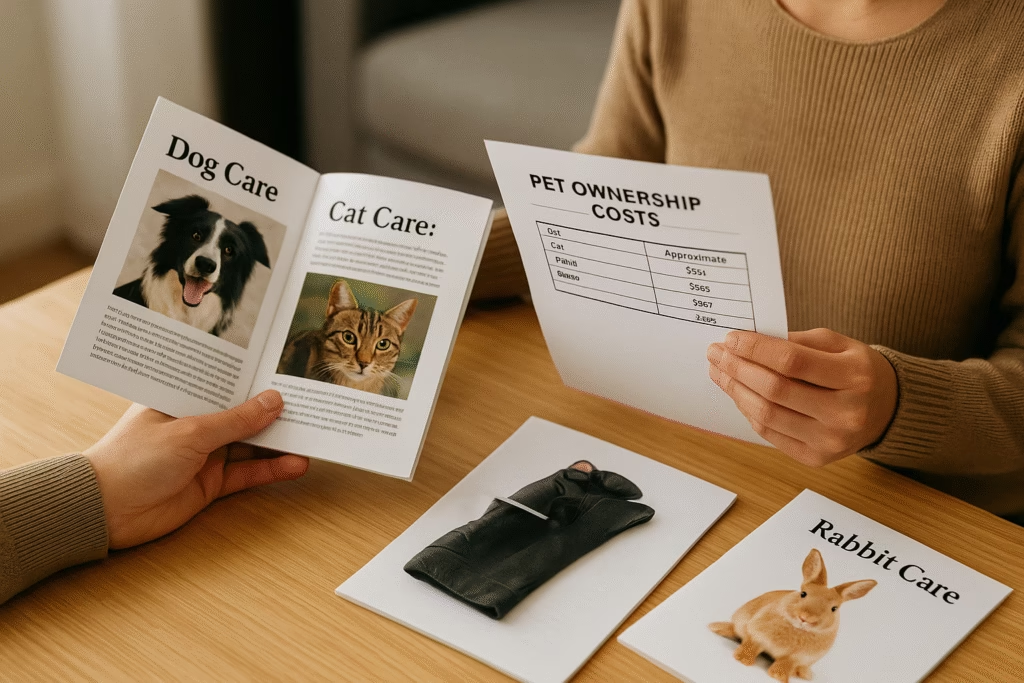How to Choose a Pet: Smart Tips for the Perfect Companion
Introduction: Why Learning How to Choose a Pet Matters
Deciding how to choose a pet is one of the most meaningful lifestyle decisions a person or family can make. Pets become lifelong companions, shaping our routines, happiness, and even our responsibilities. When people rush into pet ownership without carefully considering their options, both the animal and the owner may face challenges such as mismatched energy levels, medical expenses, or unmet expectations. That is why understanding how to choose a pet thoughtfully is essential.
The first step in learning how to choose a pet is to evaluate your lifestyle. Do you work long hours, travel frequently, or live in a small apartment? Each of these factors affects whether a cat, dog, rabbit, bird, or even fish might be the most suitable choice. For instance, dogs often require more exercise and attention, while cats may be more independent. Knowing this helps narrow down your options in a practical way.
Beyond lifestyle, thinking about long-term commitment is equally vital. When researching how to choose a pet, many people overlook the fact that some pets live for decades. Birds and turtles can easily surpass 20 years, while smaller animals may only live a handful of years. Matching expectations with reality ensures you are ready for the responsibility. By carefully exploring how to choose a pet, you prepare yourself for a rewarding experience filled with joy and companionship, instead of frustration and regret.
Key Factors in How to Choose a Pet
Understanding the key factors involved in how to choose a pet makes the difference between a smooth transition and overwhelming stress. Too many first-time owners underestimate how much time, money, and attention pets require. When researching how to choose a pet, you should always start by examining your daily lifestyle. For example, if you live in a city apartment, a large high-energy dog may not be suitable. On the other hand, smaller pets such as cats, hamsters, or reptiles may adapt easily. Matching your living space with the pet’s natural needs is the foundation of responsible ownership.
Another major factor in how to choose a pet is the cost of long-term care. Many people assume that only food is necessary, but medical bills, grooming, insurance, and accessories can quickly add up. Cats and dogs require vaccinations and check-ups, while exotic pets may need specialized vets, which are often harder to find. Doing a financial breakdown before deciding on a pet ensures that you are ready for the full commitment. If you are unsure about budgeting, resources like the ASPCA Pet Care Guides provide excellent cost breakdowns and care expectations.
Time commitment is another critical element in how to choose a pet. Dogs, for instance, need daily exercise and interaction, while cats often require less direct attention but still crave companionship. Birds may need mental stimulation, and reptiles often demand strict environmental conditions. Consider whether you or your family members have enough time to consistently provide enrichment and care. If you often travel, finding a pet that can thrive with minimal interaction might be more responsible.
Allergies and health concerns should also guide how to choose a pet. Many households discover late that one member is allergic to cats or dogs, forcing them into difficult choices. Researching hypoallergenic breeds or alternative pets can prevent this painful scenario. Finally, temperament and training requirements matter. Some pets are naturally independent, while others thrive on constant interaction. Taking the time to evaluate personality compatibility ensures harmony between you and your new companion. When carefully weighed, these factors reveal the true process of how to choose a pet that will enhance your life rather than complicate it.

Step-by-Step Guide on How to Choose a Pet
Step 1: Assess Your Lifestyle and Environment
The first step in learning how to choose a pet is to take an honest look at your lifestyle and living conditions. People often select pets based on looks or trends, but long-term compatibility is determined by daily life. For instance, if you live in a small studio apartment, adopting a large energetic dog could create frustration for both you and the pet. Instead, cats, small dogs, or low-maintenance pets like fish may fit better. Families with children must also consider how active or gentle a pet is, since some breeds or species are more tolerant of younger kids. When thinking about how to choose a pet, make a checklist of your daily schedule, work commitments, travel frequency, and home size to help narrow down suitable companions.
Space is not the only environmental factor in how to choose a pet. Noise sensitivity, neighborhood rules, and even climate affect the decision. Birds and dogs may be noisy, which might not suit apartment complexes with strict sound limits. Similarly, reptiles and amphibians often require heated enclosures that may raise utility costs in colder regions. Before you make a decision, reflect on whether your environment supports the pet’s natural behaviors and health needs. By doing this, you make the first big step in successfully understanding how to choose a pet.
A good resource for deeper research is the Pet Overview on Wikipedia, which outlines the general categories and expectations of different animals. Gathering information prevents impulsive choices and ensures that the new companion can thrive in your unique situation. This groundwork lays the foundation for the next stages of how to choose a pet, where time, budget, and family needs must also be considered.
Step 2: Consider Time, Budget, and Commitment
The second step in how to choose a pet focuses on your long-term responsibilities. Many people underestimate the costs and time required to care for an animal properly. Dogs may need several walks daily, while cats need playtime and grooming. Birds require intellectual stimulation, and reptiles need regulated enclosures. If your lifestyle is already packed, a pet with high attention needs may cause stress. This is why evaluating time is essential in understanding how to choose a pet.
Financial planning is equally important in choosing a pet. Food, bedding, healthcare, grooming, and occasional emergencies add up over the years. Dogs and cats often require annual vet visits, vaccines, and spaying or neutering. Exotic pets, while sometimes smaller, may involve expensive specialized vets. Make a budget for monthly and yearly expenses before deciding. Reliable organizations like American Veterinary Medical Association offer detailed breakdowns of what to expect.
The emotional aspect of commitment is another layer in how to choose a pet. Some pets, such as parrots and turtles, can live 20–50 years, essentially becoming lifetime companions. Others, like hamsters or rabbits, may live only a few years but still demand daily attention during their lives. Knowing this helps you prepare emotionally and practically. Families must also agree on who takes care of feeding, cleaning, and medical visits to avoid conflicts later. When planned carefully, this step secures the foundation of how to choose a pet responsibly.
Step 3: Match Personality and Compatibility
The final step in how to choose a pet is to think about personality compatibility. Pets are not one-size-fits-all; each has distinct traits that may or may not align with your household. For example, some dog breeds are highly active and need constant exercise, while others are calm and independent. Cats can be affectionate or aloof, depending on their temperament. Birds often thrive on interaction and stimulation, while reptiles are generally low-maintenance but less interactive. When evaluating how to choose a pet, think about whether you prefer a playful, social animal or one that is more self-sufficient.
Compatibility also extends to your family structure. If you have small children, a gentle and patient animal is crucial. If you live alone, you may want a companion that keeps you company but does not require extensive training. Some people want pets that bond deeply, while others prefer animals that are beautiful to watch but less demanding, such as fish or exotic reptiles. These personality-based questions are at the heart of choosing a pet.
Finally, always meet the pet before finalizing your decision. Shelters and breeders often allow potential owners to spend time interacting with animals before adoption. Observing behavior firsthand gives you a clearer picture of compatibility. When practiced thoughtfully, this ensures that how to choose a pet becomes a positive journey, leading to a lasting and fulfilling companionship for both you and your chosen pet.
Common Mistakes People Make in How to Choose a Pet
Even with the best intentions, many first-time owners fall into avoidable traps when deciding about choosing a pet. One of the most frequent mistakes is selecting an animal based solely on appearance. Cute puppies or exotic animals often capture attention, but beauty does not guarantee compatibility. A dog with striking looks may have high energy demands that overwhelm your lifestyle, or a rare reptile might require advanced care you are unprepared for. Taking the time to research breeds and species is a critical step in avoiding these pitfalls in how to choose a pet.
Another common error in choosing a pet is ignoring long-term responsibility. People sometimes adopt pets impulsively during holidays or special occasions, without realizing that the animal will be with them for years. This leads to overcrowded shelters when owners surrender pets they cannot care for. Instead of impulse adoption, use resources such as Humane Society adoption guides to better understand what the process entails. By planning carefully, you turn how to choose a pet into a sustainable decision rather than a short-term emotional reaction.
Overlooking budget and medical needs also complicates how to choose a pet. Many families focus on food and toys, forgetting that veterinary care, grooming, and potential emergencies can become costly. Exotic pets, in particular, may need specialized vets that are harder to find. Similarly, failing to consider allergies or health issues in the household may create unnecessary stress. Researching breed tendencies and possible health problems ensures that how to choose a pet aligns with your financial and medical readiness.
Lastly, skipping personality evaluation is a huge mistake in choosing a pet. Every animal has unique behaviors and energy levels. A highly active breed may struggle in a sedentary household, while an independent cat may frustrate someone seeking constant affection. Ignoring compatibility increases the chance of rehoming, which is emotionally draining for both the pet and the owner. By recognizing these mistakes and avoiding them, you approach how to choose a pet with clarity and responsibility, ensuring a positive outcome for everyone involved.

Conclusion: Making the Best Choice on How to Choose a Pet
Choosing an animal companion is both exciting and life-changing, and the process of understanding how to choose a pet should never be rushed. A pet is not just a temporary addition to your household—it is a long-term commitment that requires planning, research, and responsibility. By taking the time to evaluate your lifestyle, financial stability, and family needs, you make the journey of how to choose a pet a thoughtful and rewarding one rather than a stressful gamble.
One of the most important outcomes of learning how to choose a pet is ensuring that both you and the animal can thrive together. The right match creates joy, companionship, and even health benefits, while the wrong match can result in frustration, financial strain, or rehoming. That is why it’s essential to weigh every factor: your living environment, time availability, and willingness to commit emotionally and financially. The investment you make in the process of choosing a pet pays dividends in loyalty, comfort, and years of companionship.
Equally important, don’t hesitate to seek professional guidance when unsure about choosing a pet. Speaking with veterinarians, trainers, or reputable shelters provides insight you might not find in quick online searches. Adoption agencies in particular often help match owners with animals that suit their personality and environment. They can explain the pros and cons of each option, helping you avoid common pitfalls in choosing a pet.
Ultimately, the best approach is one that balances heart and logic. While emotional connection is powerful, research and preparation ensure sustainability. If you dedicate time to understanding how to choose a pet, you set yourself up for years of joy, loyalty, and companionship with your new family member. A well-chosen pet will not only enrich your life but will also benefit from the stability and care of a household that truly understands its needs. That is the real reward of knowing how to choose a pet—a lifelong bond filled with trust and happiness.
FAQ on Choosing a Pet
What is the first step in how to choose a pet?
The very first step in how to choose a pet is evaluating your lifestyle and living space. Consider how much time you can dedicate to daily care, whether your home has enough room for an active animal, and how much noise your neighbors or household can tolerate. This evaluation helps you narrow down which types of pets are realistic choices, making how to choose a pet much easier and more focused.
How much money should I budget when deciding how to choose a pet?
Budget is a major factor in how to choose a pet. The costs go far beyond food; veterinary care, grooming, training, and emergency expenses all add up. Dogs and cats may require annual vet visits and vaccines, while exotic pets might involve specialized care. Researching estimated costs before adopting ensures that how to choose a pet aligns with your financial stability.
Can allergies affect how to choose a pet?
Yes, allergies play a significant role in choosing a pet. Many families adopt a dog or cat only to later discover that someone has pet allergies, which can cause discomfort and even force rehoming. To avoid this, spend time around the type of animal you are considering. If allergies are present, look into hypoallergenic breeds or alternative pets. Factoring health conditions into choosing a pet prevents stress and disappointment.
Is adopting from a shelter a good way to learn how to choose a pet?
Absolutely. Adoption centers and shelters provide excellent opportunities to practice how to choose a pet wisely. Staff members often guide you toward animals that fit your lifestyle, and adoption usually includes vaccinations and initial medical care. Shelters also allow you to interact with pets before deciding, which is a critical part of successfully learning how to choose a pet. Meeting an animal in person helps you assess temperament, energy level, and compatibility, ensuring that you make the right decision. Adoption not only saves lives but also gives you valuable insight into how to choose a pet responsibly.
How do I make sure my family agrees on how to choose a pet?
Family consensus is crucial in how to choose a pet. Before bringing an animal home, discuss responsibilities such as feeding, walking, cleaning, and vet visits. If responsibilities are unclear, conflicts may arise, leading to stress for both the pet and the family. A shared plan ensures everyone participates, making how to choose a pet a positive experience.
Read Similar Topics

Share this:
- Click to share on Facebook (Opens in new window) Facebook
- Click to share on X (Opens in new window) X
- Click to share on LinkedIn (Opens in new window) LinkedIn
- Click to share on Reddit (Opens in new window) Reddit
- Click to share on X (Opens in new window) X
- Click to share on Threads (Opens in new window) Threads
- Click to share on WhatsApp (Opens in new window) WhatsApp




